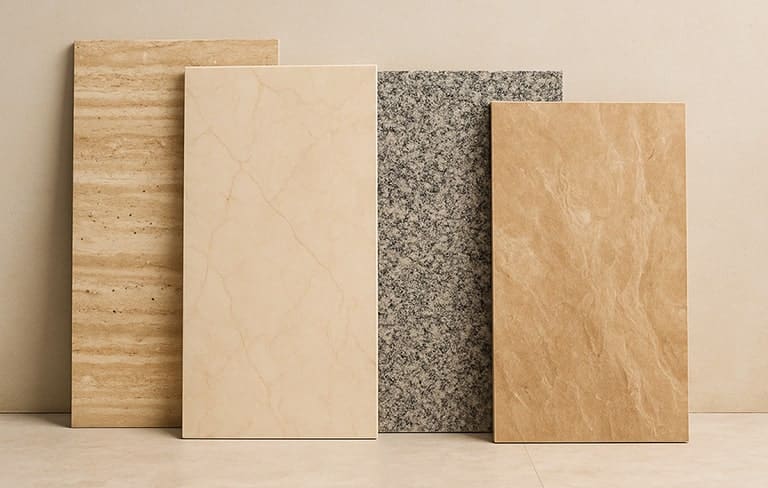
What are the differences between travertine and marble?
2025-03-15
The Difference Between Polished and Leathered Stone: Which Is Best for Your Project?
2025-04-15Veined or Non-Veined Stone: Which Is the Better Choice for Building Facades?
In architectural design, the building’s facade is the first element that captures the viewer’s attention. Not only does it play a key role in shaping the visual identity of the structure, but it also acts as a protective shield against environmental elements. Among the various materials used for facades, natural stone is one of the most popular choices. Thanks to its durability, beauty, and wide variety of colors and textures, natural stone has long been used in both interior and exterior architecture.
However, when it comes to selecting the right type of stone, one common question often arises: Should you go for veined stone or non-veined stone? These two types differ significantly in terms of aesthetics, performance, and installation. In this article, we’ll explore their differences to help you make an informed choice.
Understanding Veined and Non-Veined Stone
What is Veined Stone?
Veined stone features natural lines and patterns that resemble waves or flowing currents. These veining patterns are often the result of millions of years of sedimentary layering or geological shifts. The visual dynamism of veined stones makes them a favorite for luxury projects, feature walls, and standout architectural elements.
To enhance the effect, veined stones are often cut using book-matching or slip-matching techniques that align the veins symmetrically across adjacent slabs.
What is Non-Veined Stone?
In contrast, non-veined stone has a uniform, consistent appearance with minimal or no visible patterns. These stones often come in solid colors like white, cream, gray, or beige and are ideal for minimalist, modern, or formal design styles. The simplicity and uniformity provide a calm, balanced aesthetic to the overall structure.
Comprehensive Comparison: Veined vs. Non-Veined Stone
-
Aesthetic and Design Perspective
| Feature | Veined Stone | Non-Veined Stone |
|---|---|---|
| Visual Effect | Artistic, dynamic, and expressive | Simple, calm, and minimalistic |
| Pattern Variety | Highly varied due to natural veining | Uniform and consistent |
| Best Suited For | Luxury, custom-designed spaces | Offices, residential, classic facades |
| Light Interaction | Strong contrast, adds depth | Even reflection, soothing visual flow |
-
Technical Performance and Durability
- Veined stone may have natural weaknesses along the vein lines, which can reduce mechanical strength under pressure or in extreme climates.
- Non-veined stone, with its denser and more uniform structure, is generally more resistant to wear, impact, and temperature variations — ideal for high-rise buildings or high-traffic areas.
-
Installation and Execution
- Veined stone requires precise alignment of patterns, skilled labor, and more time during installation. Matching veins between slabs is a delicate and artistic process.
- Non-veined stone is much easier and faster to install, requiring no pattern alignment. This makes it more cost-effective in terms of labor and installation time.
Cost Considerations
| Factor | Veined Stone | Non-Veined Stone |
|---|---|---|
| Raw Material Price | Higher due to uniqueness | More affordable |
| Processing Costs | Higher — requires precision cutting | Lower — simple and faster processing |
| Installation Cost | More expensive — needs expert labor | Lower — easy installation |
| Maintenance | More difficult due to grooves/ridges | Easier — smooth and easy to clean |
Pros and Cons at a Glance
✔ Pros of Veined Stone:
- Striking and artistic appearance
- Ideal for standout architectural features
- Creates a sense of movement and elegance
❌ Cons of Veined Stone:
- More expensive in terms of material and labor
- Needs careful planning and skilled execution
- May be mechanically weaker at vein lines
✔ Pros of Non-Veined Stone:
- Cost-effective and easy to install
- More durable and low maintenance
- Perfect for minimalist and modern styles
❌ Cons of Non-Veined Stone:
- Lacks visual variety or dramatic effect
- May feel too plain for luxury projects
How to Choose the Right Stone for Your Project
Here are a few key factors to consider when deciding:
- Design Style: For bold and artistic facades, veined stones offer drama and flair. For clean, modern, or classic designs, non-veined stones provide the desired simplicity.
- Budget: If you’re working within a tight budget, non-veined stones are more economical in terms of material and installation.
- Location and Climate: In dusty, rainy, or polluted environments, non-veined stones are easier to maintain and clean.
- Building Type: For public, commercial, or high-traffic buildings, non-veined stones are more practical. For high-end villas, lobbies, or galleries, veined stones can create an impressive focal point.
Creative Combination: Using Both Veined and Non-Veined Stone
An increasingly popular design trend is the combination of both veined and non-veined stones. For instance, use non-veined stone as the base facade for a clean look, and highlight key areas like entrances, columns, or window frames with veined stone for visual impact. This method balances design aesthetics, performance, and cost-effectiveness.
Final Thoughts
Choosing between veined and non-veined stone is not simply a matter of taste — it’s a strategic decision based on design needs, technical factors, and budget. Both types have unique advantages and applications. When used correctly, each can contribute to creating a facade that is both beautiful and long-lasting.
Always consult with architects, designers, or stone specialists before making your final decision. A thoughtful choice today can ensure a timeless, elegant facade for years to come.




